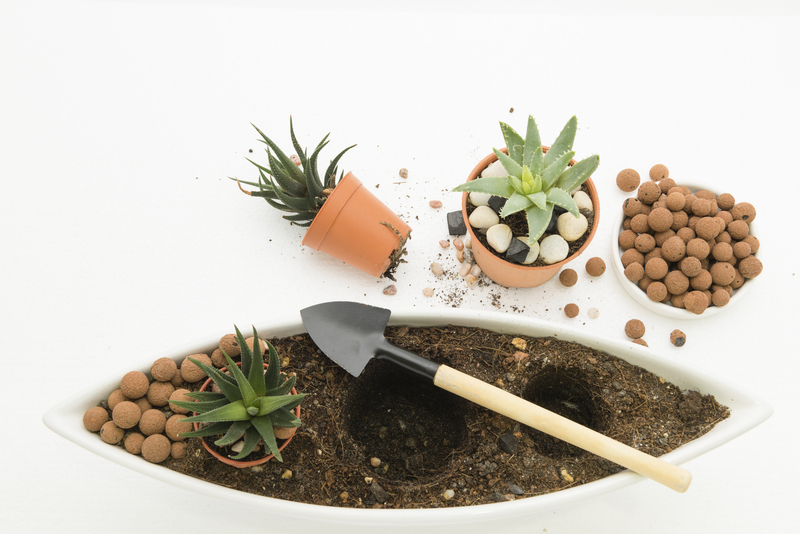Where to Begin With Your Forgotten Garden Revival
Posted on 04/06/2025
Where to Begin With Your Forgotten Garden Revival
Have you inherited a neglected green space or stumbled upon a once-loved garden that's now overgrown and forgotten? Reviving a forgotten garden can be an incredibly rewarding project, transforming a wild tangle into a rejuvenated haven that buzzes with plant and wildlife activity. But with brambles, weeds, and faded memories hiding what lies beneath, where do you even begin with your forgotten garden revival? This comprehensive guide will walk you through every step to breathe new life into your lost garden sanctuary.
Understanding Forgotten Gardens: More Than Just a Mess
When approaching a neglected or abandoned garden, it's important to remember that a forgotten garden isn't just an untidy plot--it's a storied landscape, often rich with potential. Old gardens frequently conceal hidden gems: mature trees, rare perennials, and the bones of homemade paths and borders. Before we explore how to start rejuvenating your forgotten backyard, let's discuss:
- Why gardens get abandoned: Life changes, property handovers, and simply running out of time or stamina can turn a once-flourishing space into a wilderness.
- The opportunities in old gardens: Mature soil, established root systems, and a unique microclimate often mean you can achieve results more quickly than in a newly established plot.
- The challenges: Thick weeds, invasive species, hidden rubbish, and potential pests are all part of the comeback story.

Step-by-Step Guide: Kickstart Your Forgotten Garden Revival
1. Survey and Assess Your Garden
Begin your garden restoration journey with a thorough assessment. Arm yourself with a notebook, camera, and perhaps even a friend to get a different perspective. Walk every inch, noting:
- Existing structures: Sheds, paths, patios, garden beds, and fences. What's salvageable?
- Mature plants: Identify any surviving trees, shrubs, or significant perennials. Mature trees, in particular, are valuable assets.
- Weed infestations and problem areas: Look for bramble-choked corners or evidence of invasive plants like bindweed or Japanese knotweed.
- Sunlight and shade patterns: Sketch out which areas get sun or shade throughout the day - this is vital for future planting plans.
- Wildlife presence: Signs of birds, bees, frogspawn, or even hedgehogs can guide later conservation efforts.
Photograph everything. These photos will serve as 'before' records and help you track progress on your garden revival project.
2. Clear, Clean, and Categorize
Don't be tempted to raze everything at once--careful cleaning preserves what's worth saving. Follow these steps:
- Remove rubbish and debris: Old pots, broken furniture, plastic litter, and non-compostable waste should go first. Always check local regulations for garden waste disposal.
- Assess and clear overgrown areas: Start with large weeds and brambles. Cutting back to ground level, but digging out roots later to prevent regrowth.
- Sort and save: If you find overgrown perennial plants, shrubs, or bulbs, mark their positions with bamboo sticks or colored string - you may be able to rescue and revive them later.
- Compost responsibly: Healthy green waste makes great compost, but avoid adding seed heads or invasive roots.
Tip: Work in sections so you don't get overwhelmed and give local wildlife time to move on.
3. Map Out the Underlying Garden Structure
As you clear and clean, patterns may emerge--hidden paths, brick edging, or even old ponds. These garden "bones" will guide your revival design. Map them out using chalk, string, or wooden stakes.
- Identify old garden beds: Raise beds usually have richer soil and may favor new plant life.
- Hardscaping features: Don't rush to demolish old pathways or patios as they can be pressure-washed, repaired, and integrated into your new design.
- Pergolas, arches, or trellises: Even if collapsed, could be restored or repurposed.
4. Soil Testing and Preparation
After years of neglect, garden soil may be depleted, compacted, or host to hidden hazards. Healthy soil is the foundation of any successful revival:
- Conduct a soil test: Use a basic kit to check for pH, drainage, and fertility. Most plants prefer a slightly acidic to neutral soil.
- Address compaction: Use a garden fork to aerate and break up compacted ground, especially in old pathways or beds.
- Add organic matter: Spread a thick layer of well-rotted compost or manure. This "feeds" tired soil with fresh nutrients and beneficial microbes.
5. Rescue, Divide, or Replace Existing Plants
Some of the most rewarding moments in a forgotten garden revival come from rediscovering and rescuing heritage plants.
- Trim and nurture survivors: Prune dead wood from shrubs, cut back spent perennials, and water deeply.
- Divide overcrowded clumps: Many perennials, such as irises and daylilies, will respond to division with renewed vigor.
- Replace or replant as needed: For plants that are dead or diseased, dig up and dispose to make room for newcomers.
6. Plan for the Future: Garden Design and Planting
With the space clearer and the structure revealed, **plan the new chapter** for your revived garden. Remember to blend the old with the new!
- Consider the local climate and conditions: Choose plants suited to your sun, shade, and soil profile.
- Opt for low-maintenance species: Especially for the first year or two, select robust shrubs and perennials that can tolerate some neglect as the soil recovers.
- Create zones or rooms: Use beds, borders, lawns, and seating areas to break up and define the space.
- Prioritize wildlife-friendly features: Birdbaths, log piles, and bee-friendly flowers help restore natural balance.
- Introduce color and structure gradually: Annuals offer fast color; evergreens provide year-round appeal.
7. Tackle Persistent Weeds and Pests
A forgotten garden makeover often means dealing with deeply rooted weeds and lurking pest populations. Be proactive:
- Mulch bare soil: A 2-4 inch layer of mulch suppresses weeds and retains moisture.
- Remove weed roots: Use a garden fork or hand tool to dig out roots of tough offenders like nettles or dock.
- Control pests naturally: Encourage ladybirds, frogs, or hedgehogs to help with aphids and slugs. Avoid broad-spectrum pesticides that harm beneficial insects.
8. Restore or Replace Hardscaping
Once overgrown plants and debris are out of the way, you may find paths, patios, or fences in need of attention.
- Clean and repair stone or brick: Power-wash, re-lay uneven slabs, and repoint bricks where needed.
- Paint or treat woodwork: Revive faded benches, sheds, or pergolas with fresh paint or wood oil.
- Consider recycled or upcycled materials: Old garden features can be reinvented as rustic planters or edging.
9. Begin Planting and Personalizing
With your groundwork in place, the really fun part begins: planting and personalizing your revived garden. Start with structure and work toward softer touches:
- Plant trees and large shrubs first: Allow time for roots to establish and provide framework for smaller plants.
- Layer in perennials, bulbs, and annuals: Aim for a mix of seasonal color and long-term foliage interest.
- Add garden art or features: A bench rescued from the undergrowth, a sculpture found in the nettles--these touches tell the story of your garden revival.
Expert Tips for a Successful Forgotten Garden Revival
- Work in manageable sections: Reviving a whole garden at once can be overwhelming. Tackle one area at a time for visible wins and motivation.
- Observe patience: Establishing a restored garden is a multi-year process. Celebrate small milestones each season.
- Document your journey: Keep a garden journal with photos and notes. You'll enjoy reflecting on your progress.
- Ask for help: Friends, family, and local gardening clubs may offer advice, labor, or surplus plants.
Benefits of Garden Restoration: Why Bother?
Why invest effort into reviving a neglected garden instead of starting fresh? There are lasting advantages to breathing new life into forgotten outdoor spaces:
- Mature beauty: Long-established trees and perennials offer instant character and shade.
- Improved biodiversity: Old gardens often have thriving microhabitats, supporting birds, bees, and beneficial insects.
- Personal satisfaction: There is a deep sense of accomplishment in transforming chaos into order and beauty.
- Sustainability: Recycling existing materials and plants means less waste and a lower carbon footprint.
Common Challenges When Starting a Forgotten Garden Revival
- Identifying hazardous materials: Check for broken glass, sharp metal, or buried rubbish.
- Dealing with invasive species: Some weeds and shrubs require persistent, multi-year efforts to control.
- Uncovering poor drainage: Sometimes, abandoned gardens suffer from compacted, waterlogged soils.
- Limited budgets: Restoration can be costly--upcycle, reuse, and swap where possible.
*Expert tip: If you discover old garden chemicals or unknown substances, contact your local environmental agency for proper disposal guidance.*

Maintaining Momentum: After the Revival
The real test of a rejuvenated garden is how it fares months and years after the initial burst of restoration energy. Keep your revived garden thriving:
- Stick to a seasonal task list: Regular weeding, feeding, and pruning keeps things manageable.
- Experiment and adapt: If one plant fails, try another. Old gardens excel when gardeners take a flexible, responsive approach.
- Welcome wildlife: Install bird boxes or bug hotels to boost beneficial species.
- Keep learning: No one knows everything! Attend local workshops, join online forums, or follow gardening blogs for fresh inspiration.
Conclusion: Your Forgotten Garden Revival Awaits
Restoring a forgotten garden is about more than taming overgrowth--it's about rediscovering history, reviving habitats, and creating an outdoor space that nourishes your soul. Starting with a careful survey, thoughtful clearing and cleaning, and a patient, step-by-step approach, you can transform even the wildest plot into a flourishing oasis.
Every garden revival is unique--and every step uncovers new stories and sources of pride. Start small, stay focused, and celebrate as each corner blossoms anew. With time and care, your lost paradise can shine brighter than ever before.
Ready to begin your own forgotten garden revival? Share your progress, ask advice, and become part of a growing community rekindling old outdoor spaces. Your garden's best days may be just around the corner!



